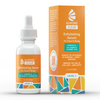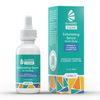AHA for Skin Care: The Common Types, Skin Benefits, and How to Use for Best Results
Ever felt lost in the skincare aisles or overwhelmed by jargon like "AHA"? You're not alone. Let's simplify skincare with Alpha Hydroxy Acids (AHAs)—your allies for a glowing, smooth complexion. In this post, we’ll explore what AHAs are, their benefits, and how you can incorporate Almond Clear’s effective products into your routine for the best results.

What Are Alpha Hydroxy Acids (AHA)?
Alpha Hydroxy Acids (AHAs) are not just your typical skincare buzzwords; they are key ingredients derived from fruits, sugarcane, and milk, celebrated for their exfoliating powers. AHAs can transform your skin's texture and appearance by gently peeling away the skin's surface layer.
How Do AHAs Work?
AHAs work by speeding up the shedding of dead skin cells from the skin's surface and promoting cell turnover. They penetrate and loosen the upper layers of skin and break down the glue-like substance that holds old skin cells together. AHAs reveal smoother, softer, and healthier skin and can help improve the skin's moisture retention by enhancing its natural barrier function.
What Are The Most Common Alpha Hydroxy Acids?
There are a variety of popular Alpha Hydroxy Acids, each serving its unique benefits. Here are some that may sound familiar and what they can do to improve your skin:
Mandelic Acid
Mandelic acid is an AHA derived from bitter almonds. Because of its larger molecular size, it is much gentler than other acids. This makes it less irritating and suitable for sensitive skin types. However, do not underestimate the power of this AHA because it can treat a variety of skin concerns, such as acne, folliculitis, hyperpigmentation, and more. Mandelic acid can improve skin texture, reduce fine lines and wrinkles, and reveal a brighter and healthier complexion.
Glycolic Acid
Glycolic acid is derived from sugar cane, and it is one of the most widely used AHAs. It has a smaller molecular size that penetrates the skin deeply. It effectively exfoliates and stimulates collagen production. Glycolic acid is also known for treating skin concerns like acne, uneven texture, hyperpigmentation, and signs of aging.
Lactic Acid
Lactic acid is derived from milk and is a hydrating AHA suitable for dry and sensitive skin types. It gently exfoliates the skin, promotes cell renewal, and improves skin tone and texture. Lactic acid is also known for maintaining skin hydration and strengthening the skin's natural barrier.
Malic Acid
Malic acid, found in apples and pears, offers gentle exfoliation and skin-brightening benefits. It helps to improve skin texture, reduce the appearance of pores, and enhance overall skin clarity. Malic acid is suitable for most skin types and can treat concerns such as dullness and uneven skin tone.
Citric Acid
Citric acid is derived from citrus fruits and is a potent antioxidant AHA that helps brighten skin. It helps to reduce hyperpigmentation, fade dark spots, and promote a more even skin tone. Citric acid also offers mild exfoliation and anti-aging benefits.
Tartaric Acid
Tartaric acid is derived from grapes. It is an antioxidant-rich AHA that provides gentle exfoliation and hydration. It helps to improve skin texture, minimize the appearance of pores, and promote a healthier complexion. Tartaric acid is suitable for all skin types, making it a great choice for sensitive skin.
What Are The Skin Benefits of AHAs

So, what can an AHA do for your skin? Alpha hydroxy acids offer a variety of skin benefits, such as:
AHAs are the Best Exfoliators For Your Skin
AHAs promote gentle exfoliation by dissolving the bonds between dead skin cells, revealing smoother skin. Regular and consistent use of AHAs helps to unclog pores, reduce congestion, and improve overall skin texture.
How Do Alpha Hydroxy Acids Exfoliate the Skin
AHAs work by breaking down the bonds that hold dead skin cells together, allowing them to slough off more easily. This process encourages cell turnover, resulting in a brighter, youthful complexion.
AHAs Boost Collagen Expression
AHAs stimulate collagen production, which helps to improve skin firmness, elasticity, and resilience. Increased collagen expression can reduce the appearance of fine lines, wrinkles, and sagging skin.
They Help Visibly Brighten Skin
AHAs promote skin cell turnover, which helps to fade dark spots, hyperpigmentation, and uneven skin tone. Consistent use of AHAs leads to a brighter and glowy complexion.
They Help Treat And Prevent Acne
AHAs can penetrate into the pores. This helps to dissolve excess oil and prevent pore congestion, making them effective in treating and preventing acne breakouts, including blackheads and whiteheads.
AHAs Help In Reducing Hyperpigmentation
AHAs target melanin production, reducing the appearance of dark spots and sun damage. They effectively treat various types of hyperpigmentation, including post-inflammatory hyperpigmentation (PIH) and sun spots.
They Minimize Sun Damage
AHAs can help to repair sun-damaged skin and fade sun spots. By incorporating an AHA in your routine you can improve the overall appearance of sun-damaged skin.
They Promote Blood Flow To Skin
AHAs stimulate blood circulation, delivering oxygen and nutrients to the skin cells. This improves skin vitality, resulting in healthier skin.
They Help Improve the Efficacy of Other Skincare Products
Another great thing about AHAs is that they have the ability to enhance the penetration of other skincare ingredients and allow them to work more effectively. This maximizes the benefits of your skincare routine and increases your chances of optimal results.
Does AHA Help With Dark Spots?
The simple answer is YES! AHAs are great at fading dark spots by promoting cell turnover and inhibiting melanin production. They help to even out skin tone and reduce the appearance of discoloration over time.
How to Choose the Best Alpha Hydroxy Acid for Your Needs
Selecting the right Alpha Hydroxy Acid (AHA) depends on a person’s skin type, concerns, and preferences:
- Skin Type: It is important to consider your skin's sensitivity and tolerance. Choose milder AHAs like lactic acid for sensitive skin and stronger AHAs like glycolic for normal to oily, non-reactive skin. All skin types can benefit from versatile AHAs like mandelic.
- Concentration: Start with lower concentrations of AHAs and gradually increase as needed. Higher concentrations offer more intense exfoliation but may be too harsh and if used incorrectly, could lead to adverse effects.
- Formulation: Choose between serums, creams, toners, or masks based on your skincare routine and preferences.
- Potential Side Effects: Be aware of potential side effects such as dryness, irritation, or increased sun sensitivity. Patch test new products and if you are not sure consider consulting a dermatologist.
How to Use AHA Products
AHA products come in various forms:
Cleansers: AHA cleansers are a convenient way to incorporate exfoliation into your daily skincare routine. Use them as you would a regular cleanser—apply a small amount to damp skin, massage gently in circular motions for 30-60 seconds, then rinse thoroughly with lukewarm water. Pat your skin dry and follow up with the rest of your skincare regimen.
A great choice is the Almond Clear Face and Body Wash. It has 2% mandelic acid and gently removes dirt and oil while brightening and clarifying the skin.
Serums: AHA serums are concentrated formulas designed to target specific skin concerns. After cleansing, apply a few drops of an AHA serum to your fingertips and gently pat onto your face and neck or body. Allow the serum to absorb fully before applying moisturizer or sunscreen.
Almond Clear’s Level 1 Exfoliating Serum and Level 2 Exfoliating Serum are great options to add to your routine. The Level 1 has 10% mandelic acid and is ideal for use on the face. The Level 2 has 15% mandelic acid and, due to its higher concentrations, is better for the body. They both work well at targeting concerns such as acne, folliculitis, hyperpigmentation, Keratosis Pilus, and ingrown hairs.
Lotions & Gels
AHA lotions and gels provide extra exfoliation and hydration throughout the day or night. After cleansing, apply a small amount of AHA lotion or gel to your face, neck, and body. It is important to avoid the eye area. Massage gently until fully absorbed.
Almond Clear’s Hydrating Gel has a low concentration of mandelic acid and is a great option for people with oily or sensitive skin. It provides hydration and additional gentle exfoliation to help optimize results.
Toners
AHA toners are designed to balance the skin's pH levels and prepare it for additional skincare steps. After cleansing, saturate a cotton pad with an AHA toner and gently swipe it over your face. Allow the toner to absorb fully before following up with a serum or moisturizer.
How Long Will It Take to See Results From Using AHA?
Results from using AHA products can vary depending on a person’s skin concerns and product formulations. Noticeable improvements in skin texture can typically be seen within a few weeks to months of consistent use. To achieve optimal results, maintain a regular skincare routine and follow product instructions.
What’s the Difference Between AHA, BHA, and PHA?
Alpha Hydroxy Acids (AHAs), Beta Hydroxy Acids (BHAs), and Polyhydroxy Acids (PHAs) are all chemical exfoliants with unique properties:
- AHAs: Primarily water-soluble and effective at exfoliating the skin's surface.
- BHAs: Oil-soluble and penetrate deeper into the pores, making them ideal for oily and acne-prone skin.
- PHAs: Similar to AHAs but even gentler and suitable for very sensitive skin types.
Who Should Use AHAs?
AHAs can be suitable for people of all skin types looking to target different concerns, such as uneven skin tone, blemishes, and aging signs. It is important to use an AHA that has a concentration suitable for your skin type.
Can I Use AHA For Oily Skin?
AHAs are effective for oily skin because they help to exfoliate the skin's surface, remove excess oil, and prevent pore congestion. Regular use of AHAs can contribute to clearer and smoother skin for individuals with oily skin types.
Can You Use AHA Every Day?
The frequency of AHA usage should be tailored to a person’s skin sensitivity and product concentration. Start with a lower frequency and gradually increase as tolerated. Daily use of AHAs may be suitable for some individuals but can increase the risk of over-exfoliation and irritation. Make sure to follow product instructions and monitor your skin's response.
Are There Any Side Effects to AHA?
Potential side effects of using AHAs include dryness, irritation, redness, and increased sun sensitivity. This is why it is important to patch-test new products and consult a dermatologist if irritation happens. Incorporate AHAs into your skincare routine gradually and use sunscreen daily to protect your skin from sun damage.
Final Thoughts
AHAs offer so many benefits for the skin, from exfoliation and acne prevention to improving skin tone and texture. You can achieve healthier skin by incorporating AHAs into your skincare routine and selecting the right products based on your skin type and concerns.
Remember to be patient and consistent with your skin care regimen to optimize the benefits of AHAs!








